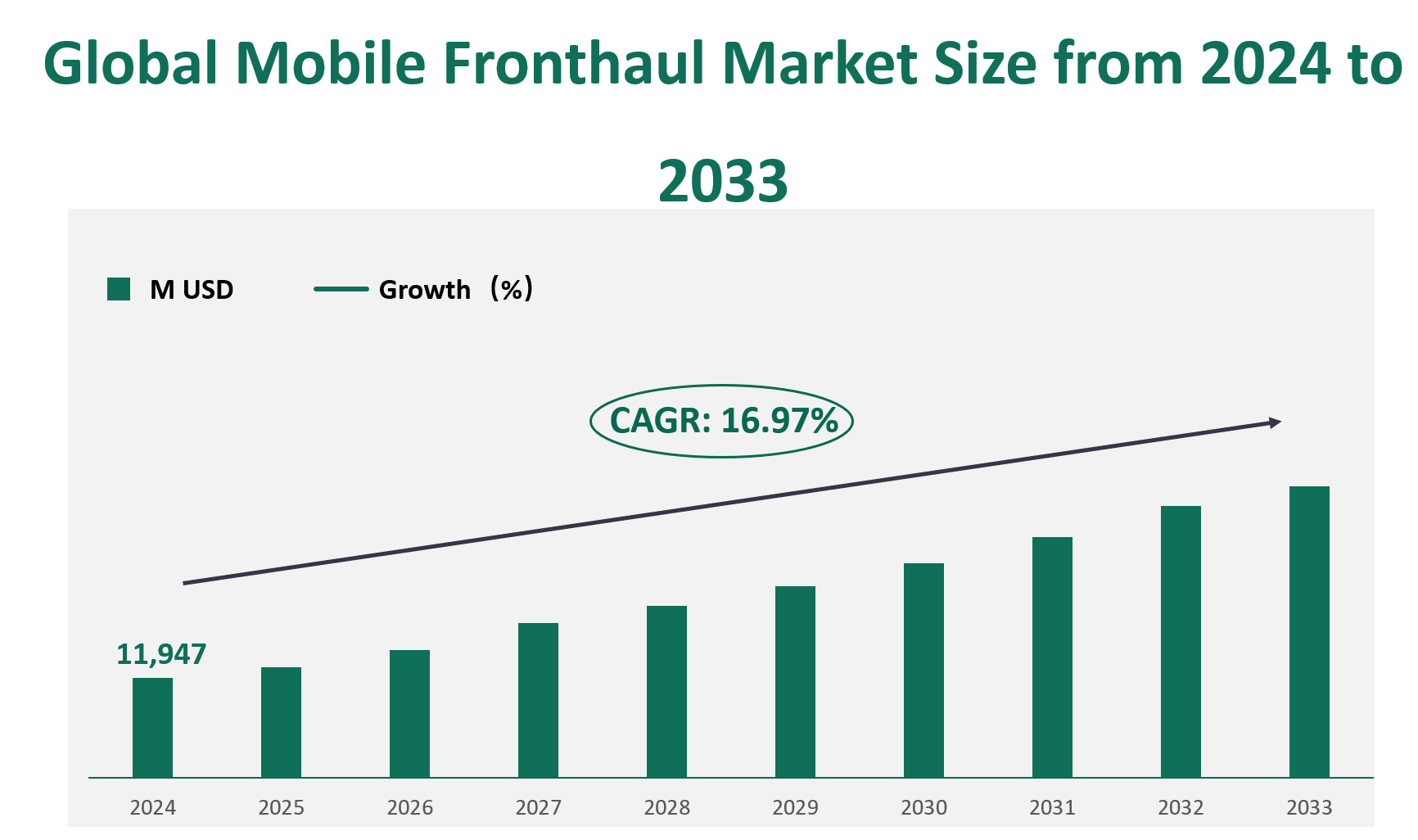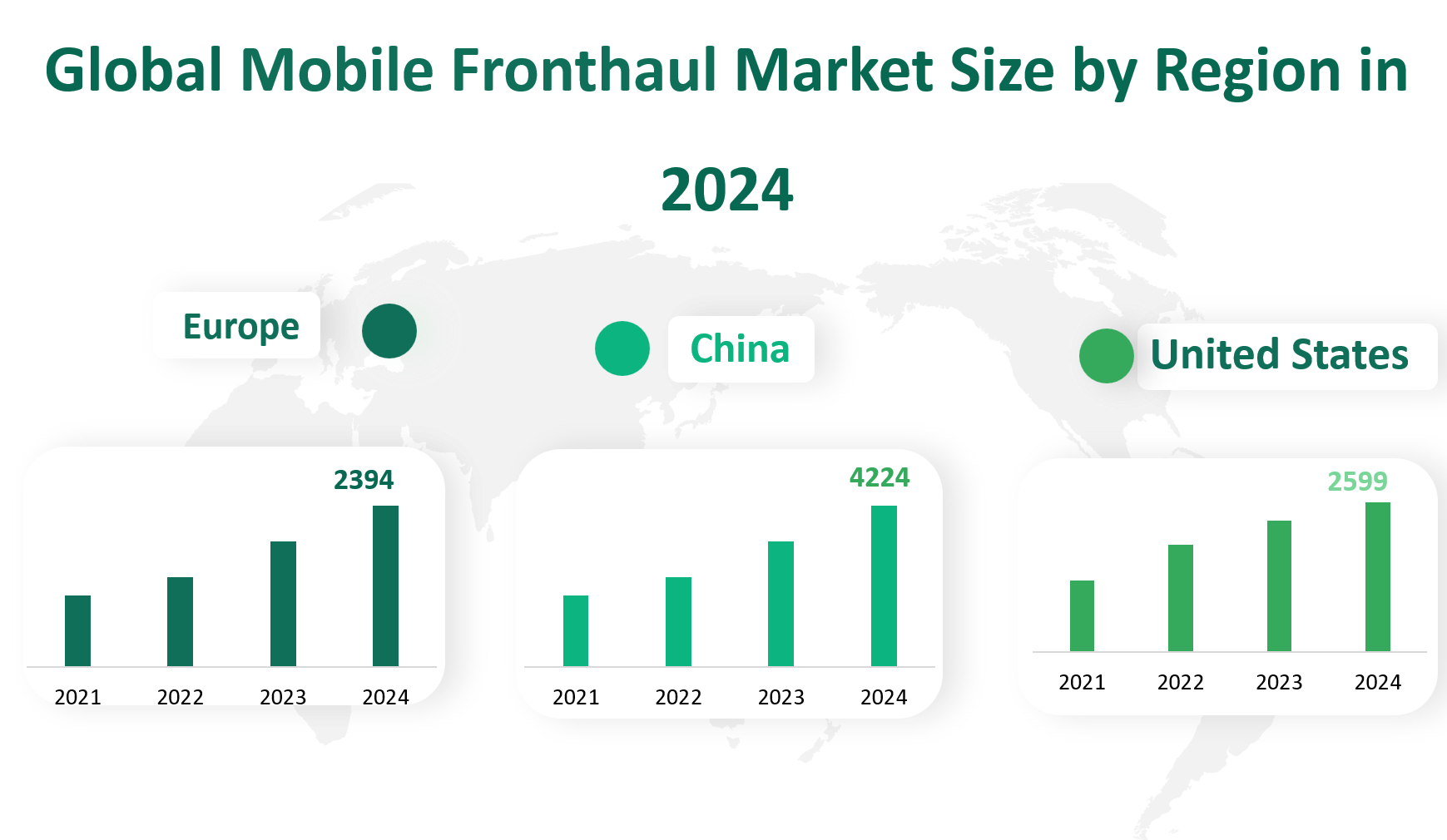1. Global Mobile Fronthaul Market Insight Analysis
The global Mobile Fronthaul market size is projected to reach 11,947 million USD in 2024, with a robust Compound Annual Growth Rate (CAGR) of 16.97% from 2024 to 2033.
Mobile Fronthaul refers to the segment of a mobile network that connects the Remote Radio Head (RRH) at the cell site to the centralized Baseband Unit (BBU). This architecture is a departure from traditional mobile backhaul models, where the BBU is located at the cell site itself. In the fronthaul model, the BBU is centralized and serves multiple RRHs, which are located at remote cell sites kilometers away. This configuration allows for more efficient resource allocation, reduced operational costs, and improved spectral efficiency.
The concept of Mobile Fronthaul is closely associated with the evolution of Radio Access Networks (RANs), particularly with the advent of 5G technology. The centralized nature of the BBU in fronthaul networks enables dynamic resource sharing and reduces the need for physical infrastructure at each cell site. This not only lowers deployment and maintenance costs but also enhances network performance by reducing latency and improving overall network reliability. The interconnectivity between the RRH and BBU is typically achieved through high-capacity optical links, which are essential for transmitting the large volumes of data required by modern wireless networks.
Figure Global Mobile Fronthaul Market Size (M USD) and CAGR (2024-2033)

2. Driving and Limiting Factors of Mobile Fronthaul Market Growth
Deployment of 4G and 5G Networks: The increasing demand for high-speed data transmission and the widespread adoption of 4G and 5G networks have significantly boosted the need for efficient fronthaul solutions. These advanced networks require broader bandwidth and lower latency, which fronthaul technology can provide. The transition to 5G, in particular, has accelerated the adoption of fronthaul architectures due to its stringent requirements for latency, reliability, and throughput.
Technological Advancements: Innovations in optical networking, such as the use of Dense Wavelength Division Multiplexing (DWDM) and Time-Sensitive Networking (TSN), have enhanced the capabilities of fronthaul networks. These technologies enable the efficient transmission of data over long distances with minimal latency, making them ideal for supporting centralized RAN architectures like Cloud RAN (C-RAN).
Cost Efficiency: Fronthaul solutions offer significant cost advantages over traditional backhaul networks. By centralizing the BBU, operators can reduce the amount of equipment required at each cell site, leading to lower deployment and maintenance costs. Additionally, the centralized architecture allows for more efficient resource utilization, further enhancing cost savings.
Increasing Demand for Data: The exponential growth in data consumption driven by the proliferation of smartphones, IoT devices, and other connected technologies has created a need for more efficient and scalable network architectures. Fronthaul networks can support this demand by providing high-capacity, low-latency connectivity between cell sites and data centers.
Strict Latency and Synchronization Requirements: Fronthaul networks must meet stringent latency and synchronization standards, which can be technically challenging to achieve. The need for low-latency transmission and precise synchronization between RRHs and BBUs can complicate network design and deployment.
Complex Network Architecture: The complexity of fronthaul networks, combined with the limited availability of suitable networking solutions, can pose challenges for operators. The integration of fronthaul with existing network infrastructure requires careful planning and execution to ensure seamless operation.
High Initial Costs: The deployment of fronthaul networks requires significant investment in optical infrastructure, including fiber optic cables and advanced networking equipment. These high initial costs can be a barrier to entry for some operators, particularly in emerging markets.
Interoperability Issues: Ensuring interoperability between different fronthaul solutions and equipment from various vendors can be challenging. This can lead to compatibility issues and increased complexity in network management.
3. Technology Innovation and Corporate Mergers & Acquisitions in Mobile Fronthaul Market
The Mobile Fronthaul market is characterized by rapid technological innovation and strategic corporate activities. Key players in the market are continuously investing in research and development to enhance their fronthaul solutions. For example, companies like Huawei, Ericsson, and Nokia have introduced advanced fronthaul products that leverage cutting-edge optical and networking technologies to meet the demands of 5G and beyond.
Corporate mergers and acquisitions have also played a significant role in shaping the market landscape. For instance, Ericsson’s acquisition of Vonage for $6.2 billion USD aims to expand its global network and communication platform, further strengthening its position in the fronthaul market. Similarly, Cisco’s acquisition of Acacia Communications for $2.84 billion USD was driven by the need to bolster its optical networking capabilities for 5G deployments.
4. Global Mobile Fronthaul Market Size by Type
Mobile fronthaul refers to the transmission links that connect remote radio heads (RRHs) to centralized baseband units (BBUs) in modern radio access networks (RANs). This architecture is designed to optimize the performance of mobile networks by centralizing processing capabilities and reducing latency. The primary product types within the mobile fronthaul market are Centralized RAN (C-RAN) and Cloud RAN (C-RAN).
C-RAN is a network architecture that centralizes the baseband processing units of multiple cell sites into a single location. This approach reduces the need for physical infrastructure at each cell site, lowers operational costs, and enhances spectral efficiency. C-RAN is particularly effective in urban areas where multiple cell sites are in close proximity.
Cloud RAN extends the concept of C-RAN by leveraging cloud computing technologies to virtualize the baseband processing. This allows for dynamic resource allocation and further reduces the physical footprint of the network infrastructure. Cloud RAN is ideal for environments with fluctuating traffic demands, as it can efficiently allocate resources based on real-time needs.
The market size for Centralized RAN is expected to be approximately $6,397 million USD in 2024. This product type has been a cornerstone of mobile fronthaul deployments, particularly in regions with dense urban networks.
The market size for Cloud RAN is forecasted to be around $5,549 million USD in 2024. The rapid adoption of cloud technologies and the increasing demand for flexible network solutions have driven the growth of Cloud RAN.
Table Global Mobile Fronthaul Market Size by Type in 2024
Market Size (M USD) 2024 | Market Share | |
Centralized RAN | 6397 | 53.55% |
Cloud RAN (C-RAN) | 5549 | 46.45% |
5. Global Mobile Fronthaul Market Size by Application
Telecommunications application segment encompasses the core functions of mobile networks, including voice and data transmission. Telecommunications applications are critical for providing seamless connectivity to end-users and ensuring high-quality service delivery. This segment includes the deployment of 4G, 5G, and future-generation networks.
Networking applications focus on the interconnection of devices and systems within the mobile network infrastructure. This includes the deployment of routers, switches, and other networking equipment that facilitate data transmission and management. Networking applications are essential for maintaining the integrity and efficiency of mobile networks.
The market size for Telecommunications applications is expected to be approximately $7,894 million USD in 2024. This segment remains the largest application area due to the continuous demand for high-speed data services and the deployment of advanced mobile networks.
The market size for Networking applications is forecasted to be around $3,504 million USD in 2024. This segment is driven by the need for robust and scalable networking solutions to support the growing demands of mobile networks.
Table Global Mobile Fronthaul Market Size by Application in 2024
Application | Market Size (M USD) 2024 | Market Share |
Telecommunications | 7894 | 66.08% |
Networking | 3504 | 29.33% |
Others | 549 | 4.59% |
6. Global Mobile Fronthaul Market by Top Regions
China emerges as the largest market by revenue, with an estimated market size of $4,224 million USD in 2024. This position is attributed to China’s rapid technological advancements, extensive infrastructure development, and strong government support for 5G and beyond. The country’s robust domestic market, combined with its role as a global hub for telecommunications equipment manufacturing, further solidifies its leadership in the Mobile Fronthaul market.
The United States follows closely, with a projected market size of $2,599 million USD in 2024. The U.S. market benefits from significant investments in 5G infrastructure, driven by major players such as AT&T, Verizon, and T-Mobile. The country’s focus on innovation and the deployment of advanced networking solutions positions it as a key player in the global market.
Europe is another major contributor, with a market size of $2,394 million USD in 2024. European countries, particularly those in Western Europe, are actively investing in 5G and mobile fronthaul technologies to enhance their digital infrastructure. The region’s strong industrial base and commitment to sustainable and efficient networking solutions drive its market growth.
Japan and Southeast Asia are also notable regions, with projected market sizes of $779 million USD and $392 million USD, respectively, in 2024. Japan’s market growth is driven by its advanced technological capabilities and focus on innovation, while Southeast Asia benefits from increasing demand for mobile connectivity and rapid infrastructure development.
Figure Global Mobile Fronthaul Market Size by Region in 2024

7. Global Mobile Fronthaul Market Analysis by Major Players
7.1 Huawei
Introduction and Business Overview: Huawei is a leading global provider of information and communication technology (ICT) infrastructure and smart devices. Founded in 1987, the company operates in over 170 countries and serves more than 3 billion people worldwide. Huawei’s business focuses on developing advanced networking solutions, including 5G and mobile fronthaul technologies.
Products: Huawei offers a comprehensive range of mobile fronthaul solutions, including its Blade OTN solution, which supports high-capacity optical transport for 5G networks. The company’s products are designed to meet the stringent requirements of modern wireless networks, including low latency and high reliability.
Sales Revenue in 2022: Huawei’s revenue in the mobile fronthaul market in 2022 was estimated at $892 million USD.
7.2 Ericsson
Introduction and Business Overview: Ericsson is a multinational networking and telecommunications company headquartered in Sweden. Established in 1876, Ericsson provides infrastructure, software, and services for telecommunications service providers and enterprises. The company is a key player in the development of 3G, 4G, and 5G technologies.
Products: Ericsson’s mobile fronthaul products include the Fronthaul 6000 series, which offers flexible and cost-efficient solutions for Ethernet, CPRI, and eCPRI transport. These solutions are designed to support high-density fiber deployment and ultra-low latency, making them ideal for 5G networks.
Sales Revenue in 2022: Ericsson’s revenue in the mobile fronthaul market in 2022 was estimated at $1,257 million USD.
7.3 Nokia Corporation
Introduction and Business Overview: Nokia is a Finnish multinational telecommunications, information technology, and consumer electronics company. Founded in 1865, Nokia has a long history of innovation and is a key contributor to the development of GSM, 3G, and LTE standards. The company focuses on large-scale telecommunications infrastructure and technology development.
Products: Nokia’s mobile fronthaul solutions include the AirFrame Fronthaul Gateway, which connects legacy CPRI-based radios to new Ethernet-based cloud architectures. The company also offers a range of optical multiplexing units and wavelength translation units to support fronthaul deployment.
Sales Revenue in 2022: Nokia’s revenue in the mobile fronthaul market in 2022 was estimated at $1,028 million USD.

